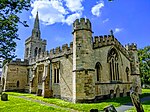Podington Castle
Podington Castle, sometimes known as Puddington Manor Farm, was an 11th-century castle in the civil parish of Podington, in the county of Bedfordshire, England. It was a Motte and triple bailey castle, surrounded by a moat, mentioned in the Domesday Book of 1086 as being owned by Hugh the Fleming. The castle was in ruins prior to the early part of the 17th century, when a new Podington Manor, now referred to as "Old Podington Manor", had been built just forward of its location. The new Podington manor became a farmhouse in 1694, when the owners moved their residence elsewhere. The extensive earthworks remains of the castle can still be located, on the mound, in the field at the back of Old Podington Manor. Building foundations were still visible as of 1972.
Excerpt from the Wikipedia article Podington Castle (License: CC BY-SA 3.0, Authors).Podington Castle
Wymington Road,
Geographical coordinates (GPS) Address Nearby Places Show on map
Geographical coordinates (GPS)
| Latitude | Longitude |
|---|---|
| N 52.2562 ° | E -0.6199 ° |
Address
Wymington Road
NN29 7HP , Podington
England, United Kingdom
Open on Google Maps










